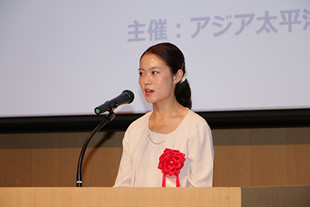 The 23rd Asia Pacific Research Prize winner: Dr. Wen Qiuying
The 23rd Asia Pacific Research Prize winner: Dr. Wen Qiuying
Title of Dissertation: “A Cultural History of the Acceptance of the Chinese Language through ‘Voices’: Seeking Another Language of Culture in Modern Japan”

- Dr. Wen Qiuying
-
- Career -
Wen Qiuying specializes in the humanistic and social informatics, and Chinese language and literature. She graduated from the School of Journalism and Communication, Wuhan University in 2018 and completed her master’s degree at the Graduate School of Education, Kyoto University in 2021. After working as a JSPS Research Fellow DC1 and a Special Inter-Institutional Research Fellow at the International Research Center for Japanese Studies, she completed her doctoral degree at the Graduate School of Education, Kyoto University in 2024 (Ph.D. in Education). She is currently an assistant professor at the Faculty of International Studies, Otani University.
- Summary -
Although Chinese is a foreign language to the Japanese people, its “otherness” has always been ambiguous and complex due to the complicated Sino-Japanese relations in modern times and the use of Chinese characters in writing. This paper, “A Cultural History of the Acceptance of the Chinese Language through ‘Voices’: Seeking Another Language of Culture in Modern Japan,” uses a cultural historical approach to elucidate the issue of how the Chinese language through ‘voices’ was accepted in modern Japan as a foreign language distinct from kanbun kundoku (the reading of Chinese texts using Japanese reading aids). In particular, it examines the behaviors of educators and learners in Japan who pursued Chinese as a “foreign language of culture” based on language learning through media such as radio and publications from the 1930s to the 1960s, and considers the implications of these behaviors and chains of thought for Japan’s perception of China and Japan-China negotiations at the time. The 1930s, the starting point for this time frame, was a major turning point in the acceptance of the Chinese language through “voices,” as new audio media emerged, became popular, and changed the distribution of the Chinese language. The end of the time frame is the late 1960s, when the linguistic modernization of both Japan and China was almost complete and the era of Takeshiro Kuraishi, who played a major role in the history of Chinese education in Japan, ended.Specifically, chapters 1 to 4 cover the period from around the 1930s to the end of the war, analyzing the Japanese Broadcasting Corporation’s radio program Shinago Koza (“Chinese language course”) from 1931 to 1941, the text space created during the same period as an “Extended Hearing” with phonetic symbols, magazines published for self-study, and the ideological trends of Shigemitsu Iwamura and Takeshiro Kuraishi who sought to reform Chinese language education. On the other hand, chapter 5 through to the final chapter focus on the postwar situation after Japan’s defeat in the Asia-Pacific War, a turning point in the acceptance of the Chinese language in modern times, and discuss the birth of “Class E” at The University of Tokyo under the new school system, where Chinese was a compulsory subject, and the developments in the radio “Chinese language course” that resumed around that time.






